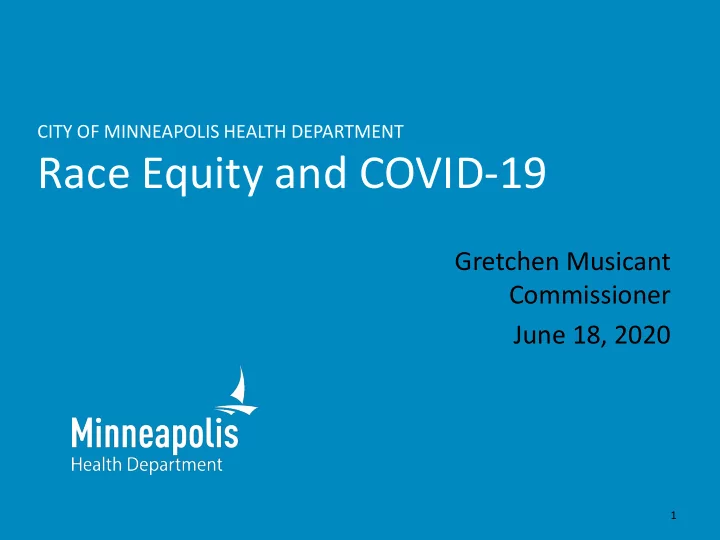

CITY OF MINNEAPOLIS HEALTH DEPARTMENT Race Equity and COVID-19 Gretchen Musicant Commissioner June 18, 2020 1
COVID-19 and Equity (per Robert Wood Johnson Foundation) The COVID pandemic underscores that: • Our health is inextricably linked to that of our neighbors, family members, child- and adult-care providers, co-workers, school teachers, delivery service people, grocery store clerks, factory workers, and first responders, among others; • Our current health care, public health, and economic systems do not adequately or equitably protect our well-being as a nation; and • Every community is experiencing harm, though certain groups are suffering disproportionately, including people of color, workers with low incomes, and people living in places that were already struggling financially before the economic downturn. 2
Health Equity Principles and COVID-19 • Collect, analyze, and report data disaggregated by age, race, ethnicity, gender, disability, neighborhood, and other sociodemographic characteristics. • Include in decision-making the people most affected by health and economic challenges, and benchmark progress based on their outcomes • Establish and empower teams dedicated to promoting racial equity in response and recovery efforts. • Proactively identify and address existing policy gaps while advocating for further federal support. 3
Disaggregated Data • Advocated for City level data • Advocated for racial/ethnic data at the City level • Created a dashboard to share disaggregated data • Track all activity, supports and technical assistance we are providing. For example we are tracking number of hygiene kits distributed to homeless individuals, number of persons tested in testing events, amount of PPE distributed • SPAC has created a list of data points that staff will match with data sources to indicate impact on BIPOC 4
Include those most affected in decision making • SPAC – representation from all of Minneapolis’ primary racial and ethnic communities • Community Engagement team and their regular contact with individuals and organizations in community for the purpose of receiving community concerns and feedback • Community Engagement/Equity becoming part of Incident Command, not buried in Operations • These efforts have resulted in: setting up testing events in communities most affected; setting up hygiene stations in areas of the City most impacted; and providing technical assistance to mosques as they prepare to open up • Engaged small businesses owned by BIPOC 5
Teams dedicated to equity • Shared Power Advisory Committee (SPAC) • Community Engagement Team • 25% of our IMT members are BIPOC • The Equity work as part of our Strategic Plan continues • The Workforce Development, IT, Communications and Collaborations work as part of our Strategic Plan while not active like our Equity work, they are still being positively impacted because of our COVID-19 response. All have components of equity within them • Community Mental Health, Testing, Homelessness, Food Access/Security, and Mitigation efforts are all attuned to specifically BIPOC communities within those efforts 6
Policy • Communication with the Big Cities Health Coalition to promote equity in COVID response and to advocate for policy change in this area. • Regular communication with our own Intergovernmental Relations and with the Local Public Health Association (LPHA) to advocate for policy change at all levels particularly as it pertains to funding for COVID efforts • Provided technical expertise to the Mayor on the creation of executive orders • Influenced operating policy around the City’s use of PPE 7
Other activities of note: • Funding to community organizations • Intentional communication within communities of color • Evaluation 8
Funding • Published a Request for Proposals in early April • Received 152 proposals for an available $100,000 • Grants were given out at the beginning of May 9
Communications • Use of media outlets geared specifically towards communities of color • Translation of communications materials • Use of translators in testing events • Use of translators in contact tracing • Leveraged existing relationships with community organizations to broaden the reach of our communications (including YCB) 10
Evaluation • Completed a hot wash of the grant making process afterwards, a process that allows those involved to review what went well about the process, what went not so well, and what could be done differently • What worked well: the speed and efficiency with which we were able to finish a process with in 4 weeks – one that can normally take several months • What did not work well: A lot of organizations wrote proposals about work that seemed really interesting and exciting, but the quality of the writing was so poor they subsequently scored lower • What could be done differently?: build into the process different ways we can acknowledge people’s really good work • Completing hot washes of testing events this week on the 2 testing events that took place last week • Quantifying the work of the Incident Management Team: Weekly tracking and reporting of services provided, partnerships developed, resources given and others to monitor and evaluate our work 11
Recommend
More recommend